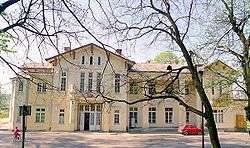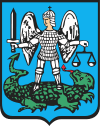Strzyżów
| Strzyżów | ||
|---|---|---|
|
Strzyżów Palace | ||
| ||
 Strzyżów | ||
| Coordinates: 49°53′N 21°47′E / 49.883°N 21.783°ECoordinates: 49°53′N 21°47′E / 49.883°N 21.783°E | ||
| Country |
| |
| Voivodeship |
| |
| County | Strzyżów County | |
| Gmina | Gmina Strzyżów | |
| Established | 9th century | |
| Town rights | 1373 | |
| Government | ||
| • Mayor | Marek Śliwiński | |
| Area | ||
| • Total | 13.93 km2 (5.38 sq mi) | |
| Population (2006) | ||
| • Total | 8,703 | |
| • Density | 620/km2 (1,600/sq mi) | |
| Time zone | CET (UTC+1) | |
| • Summer (DST) | CEST (UTC+2) | |
| Postal code | 38-100 | |
| Area code(s) | +48 17 | |
| Car plates | RSR | |
| Website | http://www.strzyzow.pl | |
Strzyżów [ˈstʂɨʐuf] is a town in Strzyżów County, Subcarpathian Voivodeship, Poland, along the Wisłok river valley. Strzyżów is one of the towns within the Strzyżowsko-Dynowskie Foothill, located 160 kilometres (99 miles) south-east of Kraków and 30 km from Rzeszów. According to statistics from June 30, 2010 from GUS (the Central Statistical Office in Poland), there are 8,782 inhabitants.
History
Legendary history of Strzyżów dates back to 9th century, the times of Wiślanie (tribe) when a pagan Wiślicki prince is said to have built a watchtower by Stobnica and Wisłok River called Strzeżno, for the defence of eastern borders of his land. In 1279 in Buda (Hungary) Pope’s legate, bishop Philip confirmed the abbot’s right to take a special tax (a tithe) from Czudec and Strzyżów. Strzyżów obtained city rights between 1373 and 1397. The town was surrounded by a soil defence embankment ( Zawale street still exists and it relates to that embankment). These were the times of town splendour and its development, craft, farming and trade contracts with other towns in Poland, Hungary and Slovakia. In 1373, Strzyżów came into the hands of a knight, Wojtko, and later Pakosz and his sons Jan and Mikołaj. With time the town changed its owners. On 15 August 1769 the Bar Confederats made an oath in front of the painting of Immaculate Mary in Strzyżów, in the presence of Kazimierz Pułaski and Franciszek Trzecielski. After this event, that image appeared on the Confedersats’ Banner. Throughout its history Strzyżów suffered from as many as nine fires, the last one in 1895 caused the beginning of brick town. In 1796 the foundation of secular school strengthened town development as well as royal permission for organisation of four fairs a year. In 1880 Strzyżów was inhabited mostly by Polish people but there were also some minorities such as Jews and Germans. 1960s and 1970s gave beginning to industrialisation of town when many factories, companies, schools and culture centres were found.
Schools
- Adam Mickiewicz Secondary School
- Technical Schools
- Municipal Schools
- White Eagle Primary School No. 1
- Maria Konopnicka Primary School No. 2
- Public Middle School No. 1
- Zygmunt Mycielski National School of Music - 1st degree
- Career Development Center
International relations
Twin towns — Sister cities
Strzyżów is twinned with:
See also
- Lendians
- Great Moravia
- Ostsiedlung
- Kingdom of Galicia and Lodomeria
- Ruthenian Voivodeship
- Lwów Voivodeship
- Pogórzanie
References
- Notes


